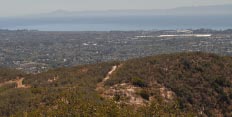The ranch’s rich history dates back to significant agricultural activities of early California, which became a state in 1850.

The ranch’s rich history dates back to significant agricultural activities of early California, which became a state in 1850. During the second half of the 19th Century, when farming in the area began to replace cattle stock raising, the rough, rocky terrain was traversed by stagecoach. The historic Stagecoach Route established in 1869 extends from Santa Barbara to the Santa Ynez Valley and crosses over the San Marcos Pass. Some of this route is evident today from the deep grooves stagecoaches wore into the sandstone, known as “Slippery Rock.”
In 1872, William W. Stowe purchased 1,043 acres (some of which is now Slippery Rock Ranch) in the Goleta Valley for $28,600. Stowe’s son, Sherman, developed the land into a farm and planted almond, walnut and lemon trees. The ranch was known as La Patera, and over time, members of the Stowe family diversified and expanded the ranch’s agricultural production.
In the 1970s, Rudi Schulte purchased hundreds of acres in the area and began planting avocados on the land. From land purchased in 2007 from Mr. Shulte, Slippery Rock Ranch arose and avocado production on the ranch has continued. Agricultural production – the largest industry in California – has the added benefit of providing a significant fire barrier, helping to protect nearby urban communities and infrastructure. In addition, great care has been taken to ensure preservation of the ranch’s native plants and animal life as well as its archaeological integrity.


